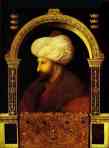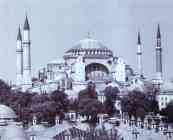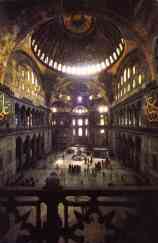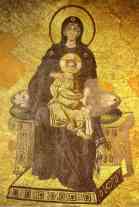Olga's Gallery
During this fortnight's period
we have added the sections of five Italian masters of the 14th-15th centuries.
The first one is Gentile da Fabriano
(1370/80 Fabriano –1437 Rome), a leading Italian master of the International
Gothic style and a teacher of numerous artists, including Jacopo
Bellini (1400-70/71), the father of Venetian painting and the founder
of a dynasty of Venetian artists.
The sections of Jacopo's two great
sons, Gentile Bellini (1429-1507),
called after Gentile da Fabriano, and Giovanni
Bellini (c.1430-1516) and his son-in-law Andrea
Mantegna (1431-1506) are also added. "Jacopo Bellini certainly wanted
to involve Andrea Mantegna in his studio – and it was maybe for this reason
that he gave his daughter Nicolosia as Mantegna’s wife – but Andrea preferred
the reserved culture of the court to the open culture of the city. If he
had not, we would have had an even more exceptional concentration of talent
in Bellini’s studio, and the next stage in Venetian painting would have
had, if not a second father, then at least a brother-in-law", Augusto Gentili.
Sultan Mehmet II
In 1479, the Republic of Venice sent
Gentile Bellini to Constantinople to paint the portrait of Sultan Mehmet
II.
 Mehmet II was born in 1433, the third of Murad’s sons. He had two elder
half-brothers Ahmet and Ali; both children of well-born mothers, whereas
Mehmet’s own mother was a slave-girl in the harem. That was the reason
why he received very little attention from his father as a child.
Mehmet II was born in 1433, the third of Murad’s sons. He had two elder
half-brothers Ahmet and Ali; both children of well-born mothers, whereas
Mehmet’s own mother was a slave-girl in the harem. That was the reason
why he received very little attention from his father as a child.
Ahmet died, in 1439, only
twenty years old. Then, in 1444, Ali was found strangled in his bed, in
circumstances still mysterious. Mehmet, now heir to the throne, was summoned
urgently to his father. Hitherto his education had been largely neglected;
suddenly he found himself in the care of the greatest scholars that could
be found and with them, over the next few years, laid the foundations of
the learning and culture for which he was soon to be famous. At the time
of his accession he is said to have been fluent not only in his native
Turkish but in Arabic, Greek, Latin, Persian and Hebrew.
Twice, in the last six years
of his life, Sultan Murad abdicated the throne in favor of his son; twice
his Grand Vizier Halil Pasha had prevailed upon him to resume the reins
of government. Young Mehmet, he reported, was arrogant and self-willed,
ever bent on going his own way and apparently determined to ignore the
Vizier’s advice. After Murad’s second reluctant return to power he gave
up all thoughts of retirement and settled down once again in Adrianople,
banishing his unsatisfactory son to Magnesia in Anatolia; and it was there
that news was brought to Mehmet that his father had died, on 13 February
1451, of an apoplectic seizure.
It took the new Sultan
just five days to travel from Magnesia to Adrianople, where he held a formal
reception at which he confirmed his father’s ministers in their places
or, in certain cases, appointed them elsewhere. In the course of these
ceremonies Murad’s widow arrived to congratulate him on his succession.
Mehmet received her warmly and engaged her for some time in conversation;
when she returned to the harem she found her infant son had been murdered
in his bath. The young sultan, it seemed, was not one to take chances.
But he was only 19, and
in the Western world there was a general feeling that he was still too
young and immature to constitute a serious threat as his father had done
– a delusion that Mehmet did everything he could to encourage, while preparing
to crush Byzantium. In January 1453 Mehmet II summoned his ministers to
his presence in Adrianople to announce them his wish to conquer Byzantium.
“On 5 April Mehmet pitched
his tent before the walls of Constantinople, where the bulk of his huge
host had already arrived three days before. Determined to lose no time,
he at once sent under a flag of truce the message to the Emperor that was
required by Islamic law, undertaking that all his subjects would be spared,
with their families and property, if they made immediate and voluntary
surrender. If on the other hand they refused, they would be given no quarter.”
As expected, he received no reply. Early in the morning of Friday, 6 April
his cannon opened fire.
The siege went on till the
end of May and finished with capture of Constantinople. “Sultan Mehmet
had promised his men the three days of looting to which by Islamic tradition
they were entitled; but after an orgy of violence on such a scale, there
were no protests when he brought it to a close on the same day as it had
begun. There was by then little left to plunder, and his soldiers had more
than enough to do sharing out the loot and enjoying their captives.
He himself waited until
the worst excesses were over before entering the city. Then, in the late
afternoon, accompanied by his chief ministers, his imams and his bodyguard
of Janissaries, he rode slowly down the principal thoroughfare, the Mes,
to St. Sophia. Dismounting outside the central doors, he stooped to pick
up a handful of earth which, in a gesture of humility, he sprinkled over
his turban; then he entered the Great Church. He had decided that the church
of the Holy Wisdom should be converted into the chief mosque of the city.
Leaving the Great Church,
he crossed the square to the old, ruined Palace on the Emperors, founded
by Constantine the Great eleven and a half centuries before; and as he
wandered through its ancient halls, his slippers brushing the dust from
the pebbled floor-mosaics – some of which have survived to this day – he
is said to have murmured the lines of a Persian poet:
The spider weaves the curtains in the palace of the Caesars;He had achieved his ambition. Constantinople was his. He was just twenty-one years old.”
The owl calls the watches in the towers of Afrasiab.
 Hagia
Sophia, Istanbul. Built by Anthemius of Tralles and Isidorus of Miletus.
Hagia
Sophia, Istanbul. Built by Anthemius of Tralles and Isidorus of Miletus.
Among the surviving monuments of Justian's reign in Constantinople,
the most important is Hagia Sophia (Church of Holy Wisdom), the architectural
masterpiece of the era and one of the great creative triumphs of any age.
Built between 532 and 537, it achieved such fame that the names of the
architects, too, were remembered; Arthemius of Thalles and Isidorus of
Miletis. After the Turkish conquest in 1453, it became a mosque (the four
minarets were added then) and the mosaic decoration was largely hidden
under whitewash. Some of the mosaics were uncovered in the 20th century,
after the building was turned into a museum.

Interior, Hagia Sophia. |

Virgin and Child Enthroned. c. 843-67. Mosaic. Hagia Sophia, Constantinople. |